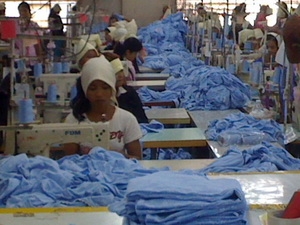Cambodian milled rice exports rise slightly
Cambodian milled rice exports rise slightly
Cambodian milled rice exports to international markets grew only 2 per cent year-on-year, leading rice trading experts to express concern that the goal of exporting a million tonnes in 2015 cannot be accomplished.
Hean Vanhorn, deputy director general of the Ministry of Agriculture and director of the single window secretariat for facilitating milled rice exports, said rice export figures at the end of 2012 shows there were only 205,717 tonnes exported, an increase of 1.9 per cent compared to 201,899 tonnes in 2011.
This milled rice was exported to 58 countries, mostly in Europe, he said, adding that France ranks number one with 47,217 tonnes and Poland second with 34,967 tonnes. Malaysia was third with 25,553 tonnes.
There were small rice exports to Africa because they are testing exports there. The export to some countries was as little as 23 tonnes, he said.
He said he could not make predictions about the rice exports to international markets of a million tonnes in the future due to the current slow growth of rice exports.
“It is difficult to predict [because it] is related to other institutions and [the] private sector. [The] private sector itself plays [a] very important role to push this task.”
Hun Lak, secretary general of The Federation of Associations of Small and Medium- Enterprise of Cambodia (FASMEC) and general director of Mekong Oryza Trading, said a decrease in milled rice exports stemmed from the competitive price of Vietnamese milled rice and long grain rice for the EU market.
He said in 2011, Cambodia’s large export of white rice focused on EU markets, which in turn tap Vietnamese rice exports last year because of its cheaper price.
“Exports to [the] EU dropped sharply due to competitiveness from Vietnam,” he said, “They sell cheap, very cheap, [so] that one tonne was [at least] $100 cheaper compared to Cambodian white rice.”
He said another important reason is that the supply capacity is still small and did not respond to their demand and they turned to buy from Vietnam.
“They want quantity, but we can’t respond. We can’t supply them. When we have, we supply; when we don’t have, we stop. They want stability.”
He said Cambodian exports of long grain rice or white rice decreased in quantity, but fragrant rice exports increased a lot because China opened its markets to Cambodian fragrant rice.
Referring to Hun Sen’s goal of exporting a million tonnes of milled rice, he said it would be long way to reach.
“[The] way to walk is far, but time for us remains over two years,” he said, adding: “The key point is co-operation among rice stakeholders, and [the] government should pay attention to look closely at this sector particular [at the] lack of capital.”
Toch Tepich, president of Svay Rieng Province Rice Millers’ Association, said he agreed there is a lack of capital leading to purchases at cheap prices during the paddy rice harvesting.
“What we face daily is our capital remains weak,” he said. “At this time… paddy rice is about $400 per tonne, but we need hundreds of thousands of tonnes for exporting,” he said.
“One million tonnes is hard, it is difficult,” he added.
phnom penh post
















